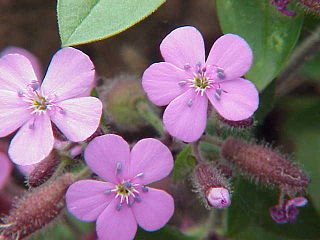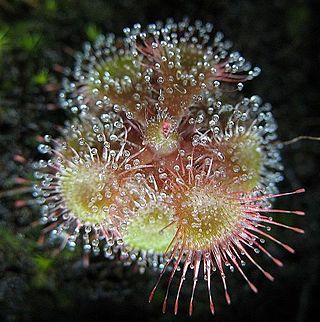
Gypsophila is a genus of flowering plants in the carnation family, Caryophyllaceae. They are native to Eurasia, Africa, Australia, and the Pacific Islands. Turkey has a particularly high diversity of Gypsophila taxa, with about 35 endemic species. Some Gypsophila are introduced species in other regions.

Saponaria is a genus of flowering plants in the family Caryophyllaceae, native to Asia and Europe, and are commonly known as soapworts. They are herbaceous perennials and annuals, some with woody bases. The flowers are abundant, five-petalled and usually in shades of pink or white. The genus is closely related to the genus Silene, being distinguished from these by having only two styles in the flower. It is also related to Gypsophila, but its calyx is cylindrical rather than bell-shaped.

The Coleophoridae are a family of small moths, belonging to the huge superfamily Gelechioidea. Collectively known as case-bearers, casebearing moths or case moths, this family is represented on all continents, but the majority are found in temperate areas of the Northern Hemisphere. They are most common in the Palearctic, and rare in sub-Saharan Africa, South America, and Australia; consequently, they probably originated in northern Eurasia. They are relatively common in houses, they seek out moist areas to rest and procreate.

Coleophora is a very large genus of moths of the family Coleophoridae. It contains some 1,350 described species. The genus is represented on all continents, but the majority are found in the Nearctic and Palaearctic regions. Many authors have tried splitting the genus into numerous smaller ones, but most of these have not become widely accepted.

Gypsophila paniculata, the baby's breath, common gypsophila or panicled baby's-breath, is a species of flowering plant in the family Caryophyllaceae, native to central and eastern Europe. It is an herbaceous perennial growing to 1.2 m (4 ft) tall and wide, with mounds of branching stems covered in clouds of tiny white flowers in summer. Another possible source of this name is its scent, which has been described as sour milk, like a baby's “spit-up”. Its natural habitat is on the Steppes in dry, sandy and stony places, often on calcareous soils. Specimens of this plant were first sent to Linnaeus from St. Petersburg by the Swiss-Russian botanist Johann Amman.

Cinnamomum burmanni, also known as Indonesian cinnamon, Padang cassia, Batavia cassia, or korintje, is one of several plants in the genus Cinnamomum whose bark is sold as the spice cinnamon. It is an evergreen tree native to southeast Asia.

Drosera burmanni, the tropical sundew, is a small, compact species in the carnivorous plant genus Drosera. Its natural geographical range includes the tropical and subtropical regions of Asia and Australia. It normally spans only 2 cm (0.8 in) in diameter. It is one of the fastest trapping sundews as well, and its leaves can curl around an insect in only a few seconds, compared to the minutes or hours it takes other sundews to surround their prey. In nature, D. burmanni is an annual, but in cultivation, when grown indoors during the cold months, it can live for many years. Since D. burmanni is an annual, it produces large amounts of seed. Drosera burmanni has been considered a powerful rubefacient in Ayurveda.

Gypsophila elegans, the annual baby's-breath or showy baby's-breath, is an ornamental plant native to Asia and Europe.

Gypsophila repens, the alpine gypsophila or creeping baby's breath, is a species of flowering plant in the family Caryophyllaceae, native to the mountains of central and southern Europe, where it grows on dry, chalky slopes. The Latin name literally means "creeping chalk-lover". It is a prostrate, mat-forming herbaceous perennial, growing around 20 cm (8 in) tall by 30–50 cm (12–20 in) wide. For much of the summer it bears masses of star-shaped flowers which may be white, lilac or light purple, in loose panicles.

Cosmotriche lobulina is a moth of the family Lasiocampidae. It is found in Europe through Siberia up to Eastern Asia.

The metallic coleophora moth is a moth of the family Coleophoridae. It is native to Europe and Armenia, but is an adventive species in the Nearctic realm, where it is found throughout the United States and southern Canada. It has also been recorded from New Zealand, Chile and Argentina.
Coleophora strutiella is a moth of the family Coleophoridae. It is found in Spain.
Coleophora kyffhusana is a moth of the family Coleophoridae. It is found from Sweden to Hungary and from Germany to southern Russia.
Coleophora niveistrigella is a moth of the family Coleophoridae. It is found from Latvia to the Pyrenees and the Alps and from France to Slovakia. It is also found in southern Russia.
Coleophora nubivagella is a moth of the family Coleophoridae. It is found from Germany and Poland to the Pyrenees, Italy, North Macedonia and Romania.
Coleophora repentis is a moth of the family Coleophoridae. It is found in the Alps and the Tatra Mountains.
Orpecacantha burmanni is a moth of the family Autostichidae. It is found in Spain.

Monopis burmanni is a moth of the family Tineidae. It is found in Austria, Poland and Russia (Ural).

Psammophiliella muralis is a species of flowering plants in the family Caryophyllaceae. It is known as annual gypsophila, cushion baby's-breath and low baby's-breath, an annual plant principally native to Europe except the British Isles. It can be also found in Central Asia, Turkey, the Caucasus, and Siberia. It is one of two species in genus Psammophiliella.

Sanrobertia is a genus of flowering plants within the subtribe Symphyotrichinae of the family Asteraceae. It is monotypic, meaning there is only one species within the genus. Sanrobertia gypsophila is a rare endemic known only from Nuevo León, Mexico.













